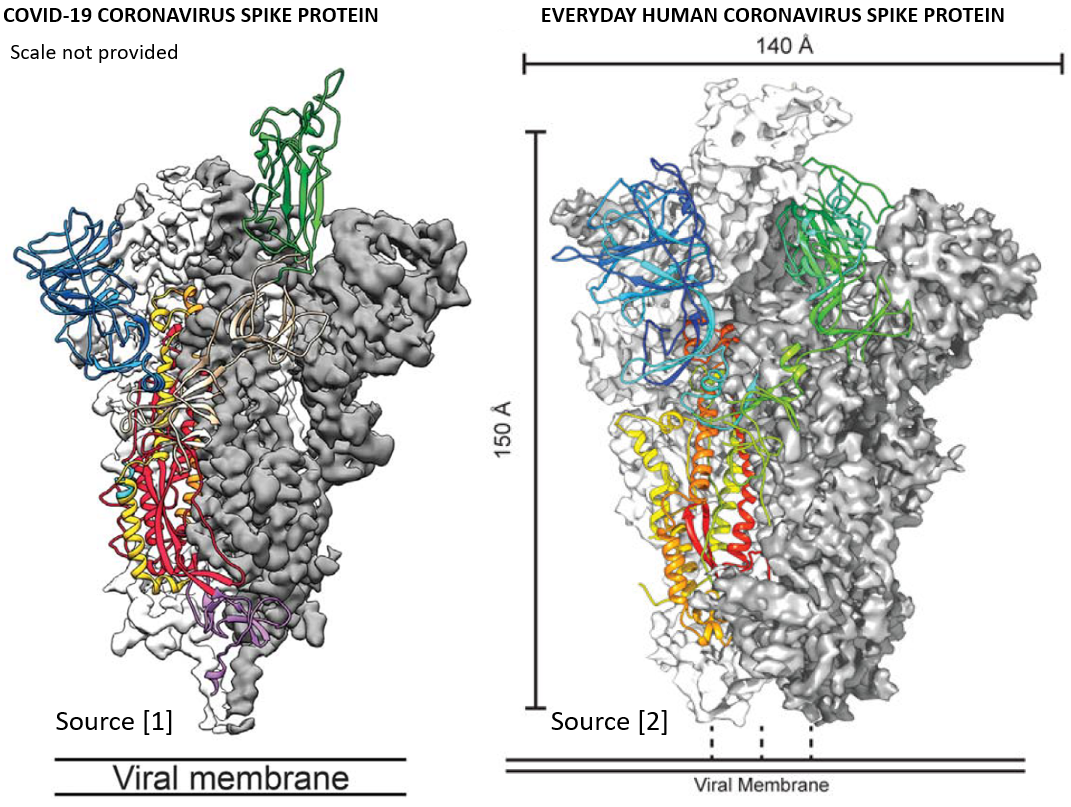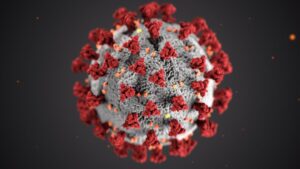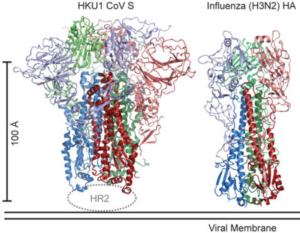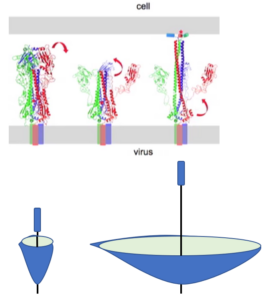This is only a blog, and in following up to my previous novice novel coronavirus (COVID-19) post, I’m simply exploring additional differences and similarities in comparison to “everyday” human coronaviruses, which for convenience I sometimes label as EHCs. The featured image is my anchor for this post. On the left is a very new (2020), but unscaled 3D rendering of the spike protein associated with the COVID-19 virus from Wrapp et al [1]. On the right is a slightly older (2016), and scaled 3D rendering of the spike protein for HKU1, “a human betacoronavirus that causes mild yet prevalent respiratory disease” [2].
The spike protein is key to the transmission of the virus. For now to reinforce, the existentially-threatening spike protein is on the left, and the everyday spike protein is on the right.
These spike proteins are the stubby parts of the coronavirus families. Here is the most commonly distributed COVID-19 3D model (unscaled) image to clarify. The red projections are the spike proteins.
As a nanoscientist I only know enough to be dangerous, but I’m hoping to translate the jargon-rich descriptions of these spike proteins into some simplified terms. That’s not easy because all of the jargon is used because it is necessary. And I appreciate the many resources which work to communicate these topics to others, or I would hardly understand anything myself. Accordingly I only ride on the backs of these other resources and I recommend that any reader not waste too much time on my viral notions and go to the sources if they want to dig in depth.
In any case, I have already taken a liberty to compare those two images side by side, even though one is not coupled to a scale. I think however that the two viruses are roughly of the same size based on some of the text in [1]. For context, here is another excerpt from [2] in which the EHC spike protein actually is compared in scale to that for an influenza virus.
As noted previously the influenza virus does look similar from the outside. But within, the influenza genome only has about 13,000 base pairs, in comparison to over 25,000 for a coronavirus. It may be helpful to point out, again as a novice, the context of the human genome (within eukaryotic cells) which comprises nearly 3 billion base pairs.Among other features that virologists explore are these docking proteins of the viral agent and the receptor proteins of the host cell. Effective vaccines are believed to approximate the morphology of a docking protein, without actually docking and killing a host cell. Such vaccines are thereby recognized by antibodies, which then are now “trained” to recognize the real virus accurately. I can best point to reference [3] for a tight synopsis by Dr. Steven Harrison of Harvard U. of how an influenza virus docks to a human cell. Here’s an excerpt/adaptation from that video which can be mapped to the previous images. I’ve added the upside down umbrella analogy.
In other words, the diffuse top of the protein unfolds like the canopy of an umbrella as the ‘shaft’ of the protein extends much like the shaft of an umbrella. Unlike a typical umbrella, the purpose of the spike protein’s shaft is to skewer a target human cell. It’s only my novice analogy, but take a look at that video for a better description. I’ll add more to this post or a later one soon, as I explore the “shaft” polypeptide sequences to compare further between the existentially-threatening and the normal-everyday human coronaviruses.
That video also notes that many viruses, including both influenza and coronavirus categories, have spike proteins that operate this same way. Their remarkable mechanisms are deeply tied to both catalysis and pH, which are two topics I happen to frequently explore in relation to the Ozone Hole and Ocean Acidification. When you witness any of the amazing animations elsewhere of “walking” protein molecules or of creepy bacteriophages in action, you are seeing pH and catalysis in some crazy but real contexts. Notably in the video I cite here, an experiment is featured that monitors pH. The sophisticated motions of the spike protein are triggered when the pH drops from 7 to about 5.5. It’s interesting to me that they can capture a subtle and challenging biochemical reaction with a measurement system having a precision of about .1 pH units or so. In comparison, the ocean acidification narrative, where shellfish are presumed to rapidly dissolve because of climate change’s evil twin, only works for those who can find a meter that is accurate to about .005 pH units. But I digressed.
Yet that’s a nice launch pad to suggest that the “evil” COVID-19 coronavirus looks and acts much like its more benign “twin”, the everyday human coronavirus (EHC). If they are indeed that similar, then two issues come to mind.
First, it is known that no vaccines have yet been developed for the already widespread EHCs, although some vaccines are routinely used for other animal-hosted coronaviruses (such as for avian infectious bronchitis). Why then are so many researchers so certain that a vaccine is rapidly on its way? As a novice, I’m keeping in mind that these docking proteins are very dynamic. They don’t necessarily sit still. With every twisting and unfolding of their joints and spiral windings, their shape changes. I hope of course that the researchers are right, but I have to ask, if only as a novice.
Second, I listened somewhat carefully this morning to an interview on the Brian Kilmeade show with Dr. Redfield of the CDC. I didn’t hear Dr. Redfield directly address a question on the mortality of the COVID-19 virus. Rather he asserted that it was Three Times More Infectious than an influenza virus. Do I have that right? If so, then I’d be interested to check those stats. I am not an expert in epidemiology of course, but I can certainly read a paper, if there is one to support his claim. Given my background in nanoscience and hydrology, I do understand the Navier – Stokes equation a bit. I think for example, that a smaller particle (for example an influenza virus) will upon ejection from a cough or a sneeze, remain in the air longer and will travel faster and farther than a larger and heavier particle (for example, a COVID-19 virus). Also, the smaller the particle, the harder it is to find. So there are a few reasons to question Dr. Redfield’s assertion.
Given the comparisons of the COVID-19 symptoms to the EHC symptoms in the previous post (they appear to be identical), then for what it is worth I wonder as many others, why our health care leadership is not waiting to get more comprehensive data before immobilizing our entire society. No one wants anyone to die prematurely, of course. And I have no doubt that social distancing works. But if we have lived with everyday human coronaviruses, in spite of the fact that there are no vaccines for them, and in spite of the fact that some people have not survived the encounter, why are we shutting everything down this time? Perhaps we will learn a great deal from this experience and find ways to maneuver around all of the viruses as we continue to socially interact. So honestly there is no disrespect intended to any. But as free citizens for the most part, our interactions can still so far include the candid questioning of any authority, whether in the climate change or health or numerous other fields.
[1] Wrapp, D., Wang, N., Corbett, K.S., Goldsmith, J.A., Hsieh, CL, Abiona, O., Grahan, B.S, and McLellen, J.S., 2020. Cryo-EM structure of the 2019-nCoV spike in the prefusion conformation. Science 367 (6483), 1260-1263 DOI: 10.1126/science.abb2507
[2] Kirchdoerfer RN, Cottrell CA, Wang N, et al. Pre-fusion structure of a human coronavirus spike protein. Nature. 2016;531(7592):118–121. doi:10.1038/nature17200
[3] Stephen Harrison (Harvard) Part 2: Viral membrane fusion https://www.youtube.com/watch?v=qcepGvFUM38&t=1491s
 6895total visits,2visits today
6895total visits,2visits today



